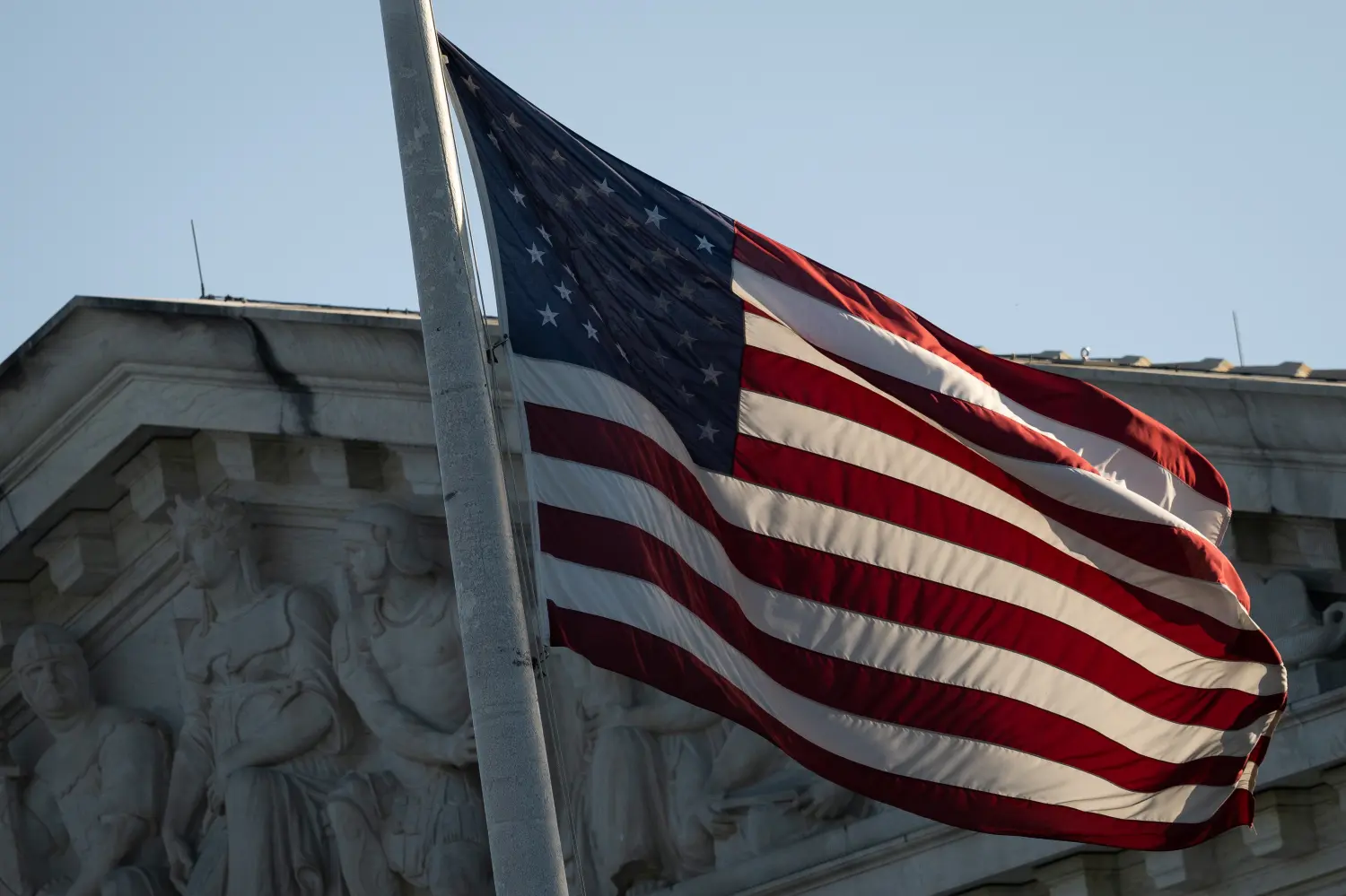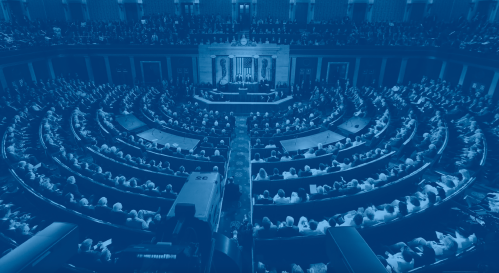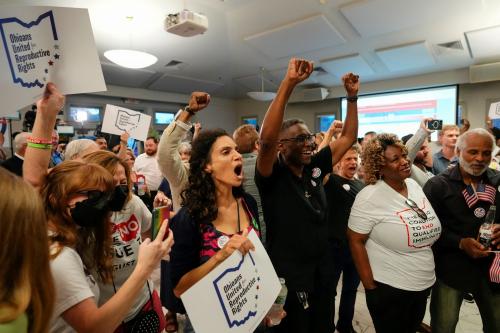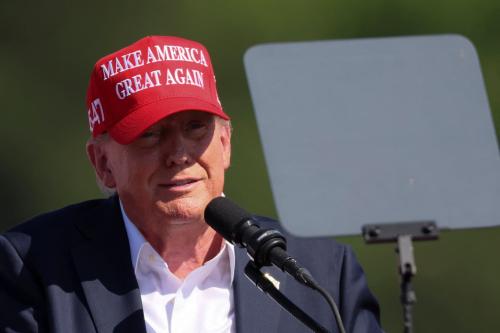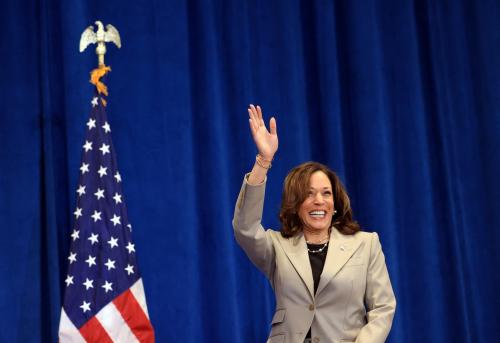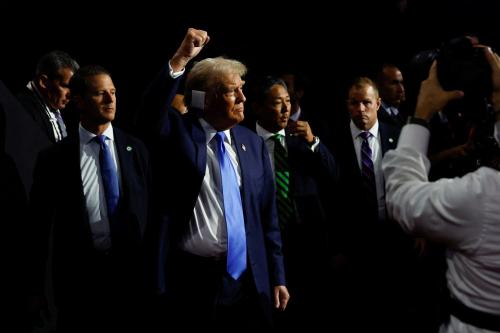Experts agree that the health of U.S. democracy has declined in recent years—but what does that mean? The United States is experiencing two major forms of democratic erosion in its governing institutions: election manipulation and executive overreach.
Most obviously, after the 2020 election, the sitting president, despite admitting privately that he had lost, attempted to subvert the results and remain in office. But democratic erosion in the United States is not synonymous with Donald Trump. Since 2010, state legislatures have instituted laws intended to reduce voters’ access to the ballot, politicize election administration, and foreclose electoral competition via extreme gerrymandering. The United States has also seen substantial expansions of executive power and serious efforts to erode the independence of the civil service. Against these pressures, the gridlocked and hyperpartisan Congress is poorly equipped to provide unbiased oversight and accountability of the executive, and there are serious questions about the impartiality of the judiciary.
What is democratic decline?
Globally, it is increasingly rare for an authoritarian to come to power via a coup.1 Instead, democracies in decline usually experience a slow but steady erosion. The process is often incremental and episodic. Each step is only partial. There can be intermediate moments of apparent stability or equilibrium.2 In the words of political scientists Daniel Ziblatt and Steven Levitsky:
“The electoral road to breakdown is dangerously deceptive… People still vote. Elected autocrats maintain a veneer of democracy while eviscerating its substance. Many government efforts to subvert democracy are ‘legal,’ in the sense that they are approved by the legislature or accepted by the courts.”3
Political scientists use a variety of terms to describe this phenomenon, including “democratic erosion,” “democratic backsliding,” “democratic regression,” and “autocratization.”
Whatever the terminology, democratic decline has ramifications throughout society. It is associated with certain changes in public attitudes, including vilification of members of the opposing party and widespread misinformation. There tends to be a decline in non-governmental institutions critical to a healthy public sphere, such as an independent media, a vibrant education system, and an engaged civil society. All these symptoms of decline are present in the United States.4
This report, however, focuses on democratic decline in the government itself because democratic backsliding tends to be driven by the choices of political leaders, not a sudden groundswell of authoritarianism in the general populace.5
The United States is experiencing two major forms of democratic erosion in its governing institutions:6
- Strategic manipulation of elections. Distinct from “voter fraud,” which is almost non-existent in the United States, election manipulation has become increasingly common and increasingly extreme. Examples include election procedures that make it harder to vote (like inadequate polling facilities) or that reduce the opposing party’s representation (like gerrymandering).
- Executive aggrandizement. Even a legitimately elected leader can undermine democracy if they eliminate governmental “checks and balances” or consolidate power in unaccountable institutions. The United States has seen substantial expansions of executive power and serious efforts to erode the independence of the civil service. In addition, there are serious questions about the impartiality of the judiciary.
Before we examine democratic decline in the United States in the 21st century, it is important to recognize the historical context.
Many longstanding aspects of America’s governing institutions can reasonably be criticized as anti-democratic or a danger to civil liberties. The Senate and Electoral College are part of the Constitution; the filibuster7 and the doctrine of “judicial supremacy” date back to the 19th century. The United States has always relied on winner-takes-all geographically based representation, which can result in substantial misrepresentation when partisans are segregated—even absent intentional gerrymandering.8 In addition, though the nation’s founders saw a standing army and strong executive as dangers to the republic, the power of the presidency has steadily increased over time and the American military has for decades been by far the most expensive in the world.
Most significantly, the United States only achieved nearly universal suffrage after 1965, when the federal government finally protected the voting rights of Black Americans in the South. The period since universal suffrage has seen massive expansions in policing and incarceration.9 The pathologies that beset American governance today are a part of the long backlash to the successes of the Civil Rights Movement.10
The idiosyncrasies of American government and the nation’s long history of race-based political exclusion create specific susceptibilities to democratic erosion, but the United States is far from alone in seeing its democracy erode. Democracy is in decline around the world. For the first time in decades, there are more closed autocracies than liberal democracies11 in the world.
Experts downgrade U.S. democracy
In 2020, then-President Trump, knowing that he had failed to win re-election, refused to concede and instead sought to subvert the vote counting and certification process. On January 6th, with President Trump’s encouragement, his supporters stormed the Capitol. The House Select Committee that investigated the January 6th attack concluded that the president had engaged in a “multi-part conspiracy to overturn the lawful results of the 2020 Presidential election.”
But 2020 does not mark the beginning of democratic decline in the United States. Precise quantitative measures of democracy are difficult to develop—there are, for example, multiple metrics used just to define gerrymandering.12 But to measure the core elements of democracy between countries and over time, social scientists have developed a robust toolkit of indices that track and aggregate indicators of electoral processes, political participation, government functioning, and civil liberties. These indices vary somewhat in their measurement strategies, but across the board, they demonstrate substantial erosion of democratic functioning in the United States for years before President Trump’s 2020 election subversion attempt.
According to the Economist, the United States now ranks not among the world’s “full democracies” (such as Canada, Japan, and most of Western Europe) but among the “flawed democracies” (such as Greece, Israel, Poland, and Brazil).
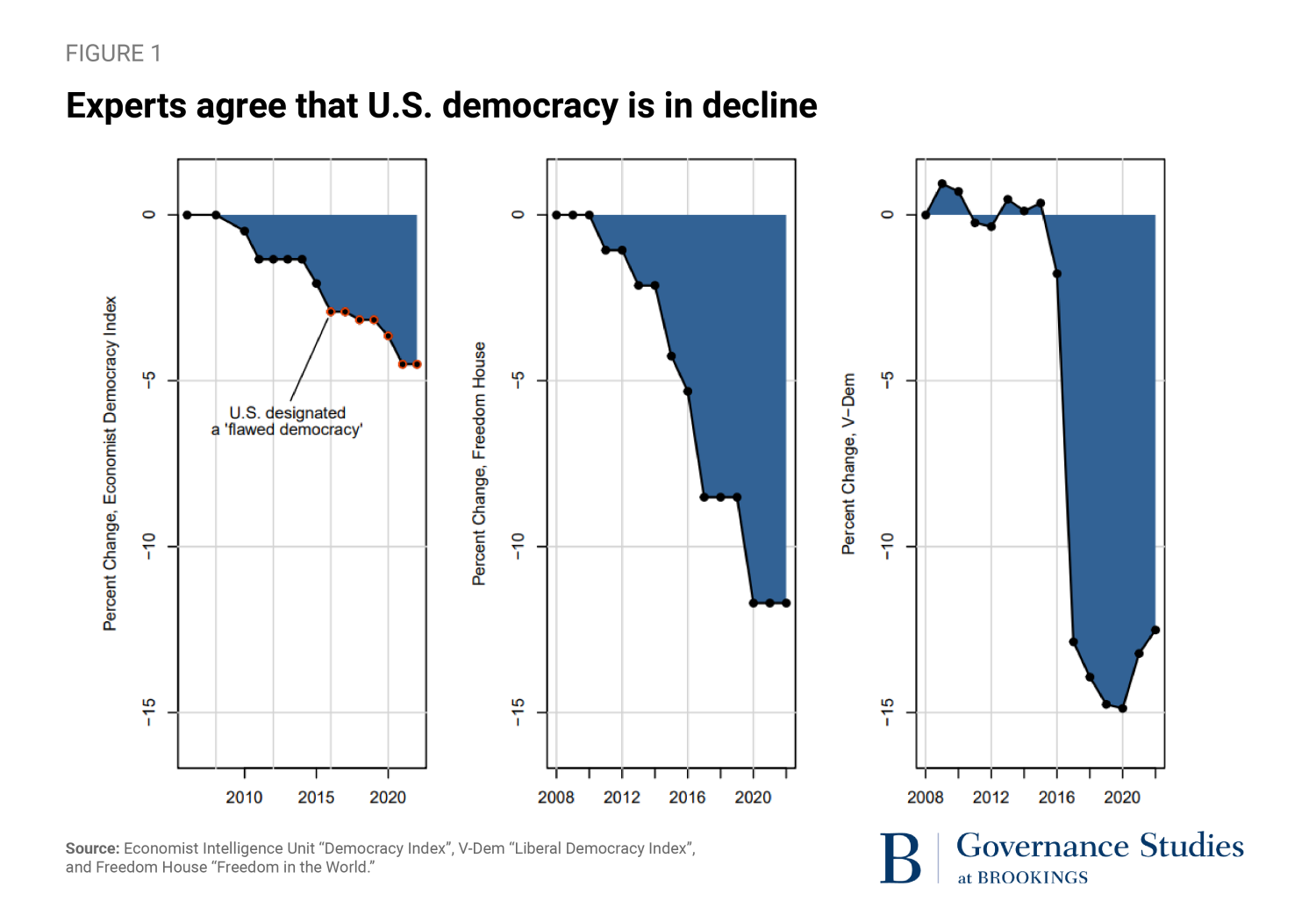
Figure 1 summarizes the ratings the United States has received since 2008 in the Economist’s Democracy Index, Freedom House’s measure of Freedom in the World, and the “V-Dem” index from the Varieties of Democracy Institute at the University of Gothenburg.13 These indices come to a consistent conclusion: Freedom and democracy in the United States is in decline. According to the Economist, the United States now ranks not among the world’s “full democracies” (such as Canada, Japan, and most of Western Europe) but among the “flawed democracies” (such as Greece, Israel, Poland, and Brazil).
What is driving these shifts? As early as 2018, the researchers at the Varieties of Democracy Institute identified concerns about inadequate checks on executive power and the freedom and fairness of elections,14 issues that also feature in Freedom House and Economist analyses.15
Strategic manipulation of elections
The American states have diverged substantially in their commitment to democratic practices. While some states have expanded voter access and strengthened impartial election administration, other states have moved in the opposite direction.16
Political scientist Jake Grumbach has developed the most comprehensive and rigorous measure of state-level electoral democracy, the State Democracy Index (SDI), which takes account of factors like polling place wait times, red tape voter registration procedures, and gerrymandering.17 The SDI quantifies the divergence occurring between U.S. states. In 2018, 17 states had a higher SDI than they did during the period from 2000 to 2010, indicating a stronger democracy in those states. The other states, however, have seen their SDI decline—some by a very substantial margin.
Figure 2 shows the 12 states at the bottom of the SDI.18 Almost all the states scoring poorly in 2018 have seen very large declines since 2010; these weak-democracy states have weakened recently and drastically.
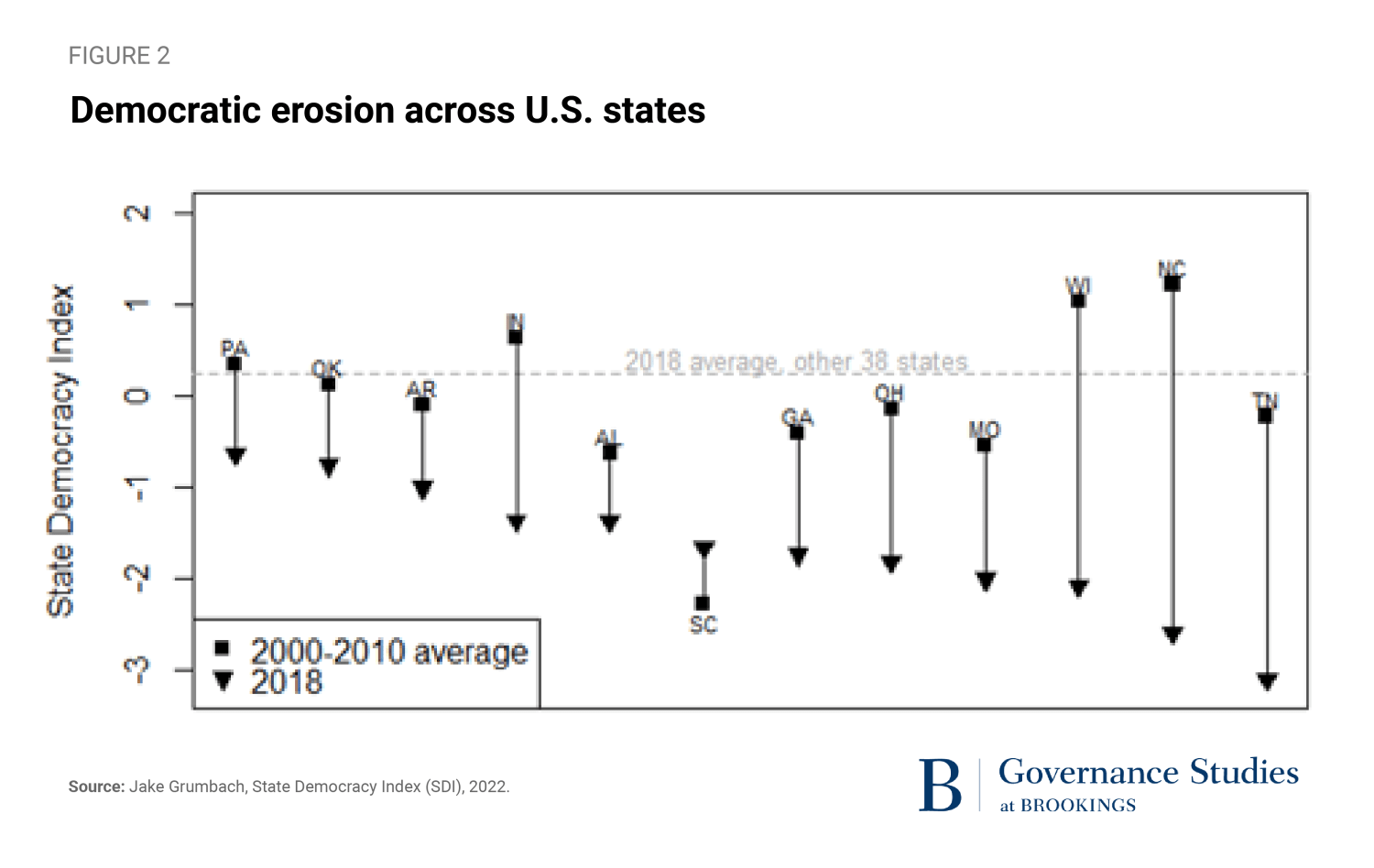
At least as important as the magnitude of the decline is the reason for this erosion of electoral democracy. Grumbach finds that partisan polarization has a “minimal role” in explaining the states’ democratic backsliding, but that Republican control of state government “dramatically reduces states’ democratic performance.”19 Grumbach’s finding confirms earlier research identifying the association between GOP control and the adoption of measures to restrict access to the ballot.20 The declining commitment to democracy is occurring both at an elite level and in the base of the party; survey research demonstrates that “ethnic antagonism” has eroded “Republicans’ commitment to democracy.”21
What has happened since 2020?
Since 2020, there have been promising signs for American democracy. For one, those who participated in the 2020 election subversion effort have faced investigation and, in some cases, prosecutions; these processes bode well for the continuance of the rule of law. In addition, the 2022 elections occurred without major incident. However, we have not seen a change in the fundamental political dynamics that led to the erosion of U.S. democracy. As long as a major political party remains uncommitted to accepting legitimate electoral defeat, democracy cannot be reasonably described as secure.
Crucially, there have been legal consequences for those who participated in the events on January 6th and for others who attempted to subvert the 2020 election. Over 1,000 participants in the January 6th invasion of the Capitol have been charged, and over 600 have pled guilty.22 For his attempted election subversion, Trump has been indicted on federal conspiracy charges and on racketeering charges in the state of Georgia.
Given the weakness of democracy in many American states and the attempted election subversion that occurred in 2020, there were reasonable worries about the 2022 elections. It was not clear whether defeated candidates would follow the election subversion playbook laid out by former President Trump. In addition, there were “election-denying”23 candidates running for state positions that would have given them substantial authority over election administration. On both fronts, the results were reassuring. Candidates generally conceded defeat soon after it was clear they had lost. The election-denying candidates running for major state positions in battleground states did not win. That said, the politicization of election administration has not ceased. Until recently, election administration was demonstrably nonpartisan,24 but in many states it has now become a partisan issue. Since 2020, state legislatures have passed dozens of laws to increase partisan control over election administration and vote counting procedures.25 Politicization also continues at the local level, with many veteran election administrators retiring and in some cases being replaced with election deniers.26
It is not at all obvious that the GOP rank and file will accept legitimate defeats in 2024, or that all prominent party leaders will validate free and fair election outcomes unless they are Republican victories.
More broadly, there is no longer a bipartisan consensus on the set of rules that govern the transfer of power. Trump remains the front-runner in the 2024 Republican presidential primary, and most of his opponents for the nomination have vowed to support him even if he is convicted of election-related crimes. The other leading contender for the GOP nomination, Florida Governor Ron DeSantis, for years refused to say whether he thought the 2020 election result was legitimate, and has campaigned for many prominent election deniers. The Republican National Committee described the attempted election subversion as “legitimate political discourse.” There are a larger number of election deniers in Congress today than in 2021. About two-thirds of Republican voters still deny that Biden legitimately won the 2020 election. It is not at all obvious that the GOP rank and file will accept legitimate defeats in 2024, or that all prominent party leaders will validate free and fair election outcomes unless they are Republican victories.
Executive aggrandizement
Democratic erosion can occur between elections. Even a legitimately elected leader can become an autocrat through executive aggrandizement: consolidating power by reducing the independence of the civil service and by undermining the “checks and balances” provided by the legislature and judicial system.
The civil service is essential to good governance, but it is also a critical component of modern democratic practice. For one, government agencies collect and release vitally important data that citizens use to assess whether politicians are doing a good job. It is critical, therefore, that government agencies in charge of reporting politically salient information (like unemployment rates or government spending figures) are not corrupted by partisan considerations. Voters need access to unbiased information. In addition, election integrity is threatened if incumbents can weaponize the provision of government services or government jobs for partisan ends—as anyone familiar with the history of machine politics in Chicago or New York can attest. Would-be autocrats commonly seek to mobilize the powers of the state to undercut political opposition and tighten their grasp on power both between and during elections.27 State institutions are either debilitated or become bulwarks of the ruling party.
To an unprecedented degree, the Trump administration and its allies sought to delegitimize, incapacitate, and politicize the independent civil service.28 Throughout his term and as part of his attempted election subversion, President Trump pressured and fired senior officials in the Justice Department.29 During the COVID-19 pandemic, the Trump administration interfered with the health reports provided by the Centers for Disease Control.30 Civil servants at every level of government experienced retaliation when their work did not comport with the claims or preferences of the administration. Entire offices were relocated to distant cities, forcing employees to uproot their families or quit. Attacks on the honesty of individual election officials, health officials, and others became commonplace, in some cases provoking threats of violence against them.31 Shortly before the 2020 election, President Trump released an executive order, “Schedule F,” intended to give him the authority to fire as many as 50,000 career civil servants. Preparations are underway to continue this process of power consolidation under a future Republican president, whether or not that president is Trump.32
Unfortunately, dysfunction in Congress leaves the legislature poorly positioned to check expansions of executive authority. At times, legislators have taken active steps that have contributed to democratic erosion. In 2016, Senate Republicans chose to leave a Supreme Court vacancy open for a year, rather than consider a nomination from President Barack Obama—an unprecedented move that increased the partisan skew of the judiciary. More recently, Republicans in Congress, with a few notable exceptions,33 have tolerated or supported President Trump’s election subversion efforts.34 But even more than its hyperpartisanship, the gridlock and inertia of the legislature make the first branch of government unable to provide the appropriate checks and balances on the executive or judiciary. Congress is slow to act, and even with united party control, often fails to make headway on policy items purported to be at the top of the party agenda.35
What about the courts?
Unlike the legislature, the Supreme Court’s power has grown substantially over time. An independent judiciary can provide a strong check on attempted election manipulation and executive aggrandizement; would-be autocrats commonly seek to curtail the powers of the judiciary or to put the courts under the control of loyalists.36 An important question, then, is the impartiality of the judiciary and the commitment of the courts to preserving democratic processes. The contemporary Supreme Court’s record is far from reassuring. What is more, the contemporary Court seems very comfortable expanding the scope of its authority; to the extent judicial decision-making approaches legislating, it violates democratic standards that put the power to make laws in the hands of an elected body.
Today, most Americans —including most Democrats and most Republicans—believe the Court is motivated primarily by politics, rather than by the law.
Judicial decision-making has never met the ideal of perfect impartiality,37 but the Supreme Court has become exceptionally conservative and partisan in recent years,38 while bypassing standard procedures, precedents, and norms that had previously governed the Court.39 President Trump was able to nominate three members to the Supreme Court, as well as an unusually high number of appeals court judges. Justice Clarence Thomas has come under scrutiny for his connections to the Trump team that attempted to overturn the 2020 election.40 Today, most Americans —including most Democrats and most Republicans—believe the Court is motivated primarily by politics, rather than by the law.
On questions of executive aggrandizement, the courts, including many very conservative judges, issued a long string of defeats to the Trump administration. On matters of administrative law, Trump lost nearly 80% of the time. But this was, legal observers agree, in large part because the administration evinced a startling disregard for even basic aspects of legal and administrative process. It is not obvious that Trump’s pattern of defeat would be repeated under a more procedurally competent administration. Scholars have suggested that the Supreme Court under John Roberts seems inclined to approve a much broader scope of presidential authority over the civil service.41 In addition, conservative members of the Court seem poised to roll back the federal bureaucracy’s longstanding regulatory functions.42
The Supreme Court has also narrowed the scope of voting rights protections and expanded its interventions in elections as they occur. Starting in 2013, the Court began cutting back the 1965 Voting Rights Act (VRA) that outlawed racially discriminatory voting practices,43 allowing states to implement procedures previously barred as discriminatory. In 2020, the Supreme Court intervened to block several emergency efforts intended to make voting easier during the COVID-19 pandemic. In 2022, the Court took the unusual step of staying an injunction against Alabama’s redistricting map that a lower court found discriminatory, effectively ensuring that the map would be in place for the election.44
In addition, the Supreme Court has expanded its authority in the adjudication of disputed elections.45 In 2000, the Supreme Court overturned a lower court ruling in the 2000 election case, Bush v. Gore, stopping a recount of votes in Florida and ensuring the election of President George W. Bush. This ruling was at the time seen as anomalous, and the majority opinion itself included limiting language suggesting that the case should not be used as precedent.46 Today, however, three participants in the Bush 2000 legal effort are now on the Supreme Court,47 and Justice Kavanaugh has cited Bush v. Gore in a 2020 election case. The recent decision in Moore v. Harper reinforced the role of the court system, and particularly the Supreme Court, in settling election disputes.
Conclusion
The effort by President Trump to subvert the 2020 election is the most obvious, but far from the only, example of democratic backsliding in the United States. State legislatures under GOP control have moved to reduce voters’ access to the ballot and to politicize election administration. President Trump also engaged in unprecedented efforts to undermine the independent civil service. The Supreme Court has increased its authority over election adjudication, narrowed the scope of voting rights protections, and seems inclined to support some politicization of executive branch administration. Hyperpartisanship and gridlock leave Congress poorly positioned to provide checks on executive and judicial power.
-
Acknowledgements and disclosures
Thanks to Naomi Maehr, Itai Grofman, and Ellis Chen for their research assistance.
-
Footnotes
- Bermeo, N. (2016). On democratic backsliding. Journal of Democracy, 27(1), 5-19. p. 6. Waldner, D., & Lust, E. (2018). Unwelcome change: Coming to terms with democratic backsliding. Annual Review of Political Science, 21, 93-113. p. 94. But the trend may be changing again: Taub, A. 2023. “Coups Are on the Rise Again. Why?” New York Times. September 13.
- See “Democratic Regress by Stealth”, p. 35 in Haggard, S., & Kaufman, R. (2021). The anatomy of democratic backsliding. Journal of Democracy, 32(4), 27-41.
- Levitsky, S., & Ziblatt, D. (2019). How democracies die. Crown. p. 5.
- Darr, J. (2021). “Local news coverage is declining—and that could be bad for American politics,” FiveThirtyEight, June 2. “As Partisan Hostility Grows, Signs of Frustration with the Two-Party System,” Pew Research Center. August 9, 2022. Cineas, F. 2023. “The ‘anti-intellectual attack’ on higher ed will take years to undo.’ Vox. Jun. 17. Skocpol, T. (2003). Diminished democracy: From membership to management in American civic life (Vol. 8). University of Oklahoma press.
- Bartels, L. Democracy Erodes from the Top. Princeton University Press. 2023.
- Bermeo 2016. “Executive aggrandizement,” p. 10. “Manipulating elections strategically,” p. 13.
- Binder, Sarah A (2010). “The History of the Filibuster.” Testimony before the Senate Committee on Rules and Administration. April 22. Fredrickson, C. (2020) “The Case Against the Filibuster.” Brennan Center. October 30.
- Reynolds, M. (2016). Republicans in Congress got a “seats bonus” this election (again). Brookings. November 22. Ingraham, G. and Wils, A. (2017). “Misrepresentation in the House of Representatives.” Brookings. February 22. Republicans started developing an advantage in less-populous states starting in the 1960s. Drutman, L. “The Senate Has Always Favored Smaller States. It Just Didn’t Help Republicans Until Now.” Five Thirty Eight. July 29, 2020. Democrats also tend to be “inefficiently concentrated in large cities.” Chen, J., & Rodden, J. (2013). Unintentional gerrymandering: Political geography and electoral bias in legislatures. Quarterly Journal of Political Science, 8(3), 239-269. See also Brown, J. R., & Enos, R. D. (2021). The measurement of partisan sorting for 180 million voters. Nature Human Behaviour, 5(8), 998-1008. Brown, J. R., Cantoni, E., Enos, R. D., Pons, V., & Sartre, E. (2022). The Increase in Partisan Segregation in the United States.
- For more on the relationship between the backlash to Civil Rights, the rise of the carceral state, and authoritarianism in the United States, see: Weaver, Vesla M. “Frontlash: Race and the development of punitive crime policy.” Studies in American political development 21.2 (2007): 230-265. Weaver, Vesla M., and Gwen Prowse. “Racial authoritarianism in US democracy.” Science 369.6508 (2020): 1176-1178.
- Mickey, R., Levitsky, S., & Way, L. A. (2017). Is America still safe for democracy: Why the United States is in danger of backsliding. Foreign Aff., 96, 20. To understand why the two parties have to a significant extent reversed their positions on issues of race, civil rights, and electoral participation since the mid-20th Century, see Richardson, Heather Cox. To make men free: A history of the Republican Party. Basic Books, 2014 and Schickler, E. (2016). Racial realignment: The transformation of American liberalism, 1932-1965. Princeton University Press.
- “Liberal democracy,” like “democracy” itself, is a contested term, but generally indicates a political system with representative government and protections for the rights of individuals.
- For a detailed discussion of many of these measures, see Grumbach, Jacob M. “Laboratories of democratic backsliding.” American Political Science Review (2022): 1-18. For a summary of the effect of gerrymandering in recent elections, see Prokop, A. “How Democrats learned to stop worrying and love the gerrymander.” Vox. April 14, 2022.
- In addition, by the Center for Systemic Peace’s “Polity5” measure, the United States dropped below the “democracy” threshold in 2020.
- “Democracy for All?” V-Dem Annual Democracy Report 2018. p. 27
- “Democracy Index 2019.” Economist Intelligence Unit. “Democracy Index 2021.” Economist Intelligence Unit. “Freedom House in the World 2017: United States.” Freedom House. “Freedom In the World 2018: United States.” Freedom House.
- In addition, many states have passed laws to restrict other fundamental civil liberties, like the right to peaceably assemble.
- Grumbach, Jacob M. “Laboratories of democratic backsliding.” American Political Science Review (2022): 967-984.
- The states selected for the figure are the 10 states with the lowest democracy scores in 2018 (the last year for which data is available), and the 10 states whose democracy scores have fallen the most compared to their average SDI score between 2000-2010. Because many states are in the bottom of both categories, the total number of states presented is 12.
- Grumbach 2022.
- Biggers, D. R., & Hanmer, M. J. (2017). Understanding the Adoption of Voter Identification Laws in the American States. American Politics Research, 45(4), 560–588.
- Bartels, Larry M. “Ethnic antagonism erodes Republicans’ commitment to democracy.” Proceedings of the National Academy of Sciences 117.37 (2020): 22752-22759.
- In Michigan, people have been indicted in Michigan for a “fake electors” scheme, which is also being investigated in Arizona, Wisconsin, Pennsylvania, New Mexico, and Nevada.
- A term used to describe those who wrongly cast doubt on the results of the 2020 presidential election.
- Ferrer, J., Geyn, I., & Thompson, D. (2023). How Partisan Is Local Election Administration? American Political Science Review, 1-16. doi:10.1017/S0003055423000631
- Fifty-six laws passed in 2021 and 2022 that make election subversion more likely, and fifteen more passed in the first four months of 2023, according to a joint report by the nonpartisan groups States United Democracy Center, Protect Democracy and Law Forward. “A Democracy Crisis in the Making: 2024 Election Threats Emerge,” p. 3-4. See also Bulman-Pozen, Jessica, and Miriam Seifter. “Countering the New Election Subversion: The Democracy Principle and the Role of State Courts.” Wis. L. Rev. (2022): 1337. For the latest news on local voting rights and election interference efforts, see Bolts Magazine’s coverage.
- Squires, C. “The Threats to Our Democracy Have Gone Local,” New York Times, April 15, 2023. Rogers, K. “It’s Hard to Run Elections These Days. Just Ask Nevada’s Election Officials.” Five Thirty Eight. October 19, 2022.
- Haggard, S., & Kaufman, R. (2021). Backsliding: Democratic Regress in the Contemporary World. Cambridge: Cambridge University Press. Haggard, S., & Kaufman, R. (2021). The anatomy of democratic backsliding. Journal of Democracy, 32(4), 27-41. Mickey, Levitsky, and Way 2017.
- Moynihan, Donald. “Delegitimization, deconstruction and control: undermining the administrative state.” The ANNALS of the American Academy of Political and Social Science 699.1 (2022): 36-49. Bauer, Michael W., and Stefan Becker. “Democratic backsliding, populism, and public administration.” Perspectives on public management and governance 3.1 (2020): 19-31.
- Estepa, J. “Here’s who President Trump pressured or fired at the Justice Department,” USA Today. January 29, 2018. “Trump fires Attorney General Jeff Sessions,” BBC News. November 8, 2018. Williams, P. “U.S. Attorney Geoffrey Berman agrees to step down after Trump fires him, House Democrats launch probe.” NBC News. June 20, 2020. Tucker, E. and Farnoush, A. “Hearing: Trump told Justice Dept. to call election ‘corrupt’,” AP News. June 23, 2022.
- Diamond, D. (2020). “Trump officials interfered with CDC reports on Covid-19.” Politico. September 9. Stolberg, S.G., Haberman, M. and Weiland, N. (2020). “Trump Calls Fauci ‘a Disaster’ and Shrugs off Virus as Infections Soar.” New York Times. October 19.
- Rizzo, S. (2022). “Local health officials report threats, vandalism and harassment during pandemic, study finds.” Washington Post. March 17. Smyth, J. C. (2022.) “Threat testimony rings familiar for election workers.” AP. June 22.
- Moynihan, D.P. (2022), Public Management for Populists: Trump’s Schedule F Executive Order and the Future of the Civil Service. Public Admin Rev, 82: 174-178. Swan, J., Savage, C. and Haberman, M. “Trump and Allies Forge Plans to Increase Presidential Power in 2025.” New York Times. July 17, 2023. Swan, J. and Haberman, M. “Heritage Foundation Makes Plan to Staff Next G.O.P Administration,” New York Times. April 20, 2023. The Heritage Foundation. “Mandate for Leadership: The Conservative Promise,” Project 2025 Presidential Transition Project. 2023. The Biden Administration has taken steps to protect the civil service.
- “GOP censures Liz Cheney and Adam Kingzinger for participation in Jan. 6 investigation,” Associated Press, Feb. 4, 2022. President Trump was impeached by the House of Representatives, with 222 Democrats and 10 Republicans voting in favor, but acquitted in the Senate, with 50 Democrats and seven Republicans voting to convict.
- Qui, L. “Republicans Try to Undercut Jan. 6 Committee with Inaccurate Claims,” New York Times. June 6.
- See, for example, the Republican failure to repeal the Affordable Care Act. Binder, Sarah. “Dodging the rules in Trump’s Republican Congress.” The Journal of Politics 80.4 (2018): 1454-1463.
- Haggard, Stephan, and Robert Kaufman. “The anatomy of democratic backsliding.” Journal of Democracy 32.4 (2021): 27-41. p. 36 Kottasova, I., Green, R.A., Gold, H.A, and Tal, A. “Israeli government passes law to limit Supreme Court power, defying mass protests.” CNN, July 24, 2023.
- Serwer, A. “The Lie about the Supreme Court Everyone Pretends to Believe,” The Atlantic, September 28, 2021. Zeitz, J. “The Supreme Court Has Never Been Apolitical,” Politico. April 3, 2022. Clark, Tom S., B. Pablo Montagnes, and Jörg L. Spenkuch. “Politics from the bench? Ideology and strategic voting in the US Supreme Court.” Journal of Public Economics 214 (2022): 104726.
- Thomson-DeVeaux, A. and Bronner, L. “The Supreme Court’s Partisan Divide Hasn’t Been This Sharp in Generations.” FiveThirtyEight. July 5, 2022. Jessee, S., Malhotra, N. and Sen, M. “The Supreme Court is Now Operation Outside of American Public Opinion.” Politico. July 19, 2022. Lazarus, S. “How to rein in partisan Supreme Court justices,” Brookings. March 23, 2022. On the role of the Federalist Society in reshaping the ideological makeup of the judiciary, see Toobin, J. “The Conservative Pipeline to the Supreme Court,” The New Yorker, April 10, 2017. Green, E. “How the Federalist Society Won,” The New Yorker, July 24, 2022.
- Lazarus, S. “How to rein in partisan Supreme Court justices,” Brookings. March 23, 2022. Totenberg, N. “The Supreme Court and ‘The Shadow Docket,’” NPR, May 22, 2023.
- Brown, E. and Helderman, R. “For John Eastman and Clarence Thomas, an intellectual kinship stretching back decades,” Washington Post, December 23, 2022. Thomas was identified by key figures in the election subversion effort as “our only chance to get a favorable judicial opinion by Jan. 6.” Justice Thomas’s wife, Ginni Thomas, had been strategizing with Trump officials to overturn the election and attended the January 6th Trump rally that preceded the invasion of the Capitol. Walsh, D. and Grisales, C. “Ginni Thomas, wife of Supreme Court justice, testifies before Jan. 6 panel,” NPR, September 29, 2022. Thomas was the only justice to oppose turning White House records over to the House committee investigating the riot; Thomas’s failure to recuse himself in this case marks a clear conflict-of-interest violation in the eyes of many judicial ethics experts. Totenberg, N. “Legal ethics experts agree: Justice Thomas must recuse in insurrection cases.” NPR, March 30, 2022.
- Isaac Chotiner, “Donald Trump’s Plan to Make the Presidency More Like a Kingship,” the New Yorker, July 18, 2023. Swan, J., Savage, C. and Haberman, M. “Trump and Allies Forge Plans to Increase Presidential Power in 2025.” New York Times. July 17, 2023. Moynihan, Donald P. “Public management for populists: Trump’s schedule F executive order and the future of the civil service.” Public Administration Review 82.1 (2022): 174-178. p. 177.
- Liptak, A. “The Curious Rise of a Supreme Court Doctrine that Threatens Biden’s Agenda,” New York Times, March 6, 2023. Deacon, D., & Litman, L. (2022). The new major questions doctrine. Virginia Law Review, forthcoming.
- In 2013, in Shelby v. Holder, the Supreme Court declared unconstitutional the formula used to apply the “preclearance” provision of the VRA, which required localities with a history of discrimination to have any changes in voting procedures approved in advance by a federal court or the Department of Justice. Two other decisions have narrowed the interpretation of Section 2 of the VRA, which outlaws discriminatory election practices.
- The reasoning behind this decision is particularly opaque given that the Supreme Court has since agreed that the map is, indeed, discriminatory. The Alabama legislature appears to have decided to reargue the case, a choice the NAACP Legal Defense Fund has described as “outright defiance of the Supreme Court’s order.”
- A matter that had previously been resolved by a commission drawing on members of Congress and the Supreme Court.
- Flanders, C. (2006). Please Don’t Cite This Case! The Precedential Value of Bush v. Gore. Yale LJ Pocket Part, 116, 141-144.
- One other justice, Clarence Thomas, was on the Court at the time and voted with the majority to stop the recount.

